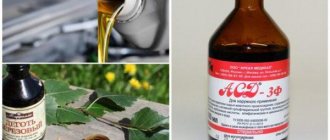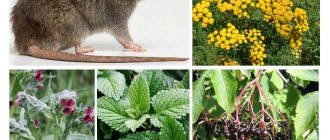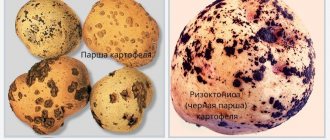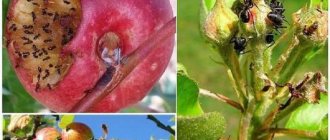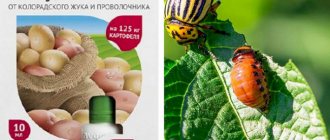Every amateur vegetable grower is especially concerned about the problem of protecting potatoes, eggplants, tomatoes, peppers and other nightshade crops from such an incredibly common pest as the Colorado potato beetle, which, whatever one may say, is the champion among the most terrible insects in our dachas. However, you should not give up, as there is a solution to this problem.
A set of proven folk and chemical remedies proposed in our article will help to adequately rectify the situation and ultimately cope with this disaster.
Advantages of traditional methods
Over many years of fighting the Colorado potato beetle, a huge number of different specialized drugs have been developed that promised quick and most effective results, but as practice shows, not everything is as positive as expected. More and more owners of potato plantings prefer traditional methods, which are usually cheap, simple and very effective.
Speaking about the benefits of folk recipes, it is worth noting the safety for both humans and the environment. Chemicals are toxic and there is always a risk of harm. Treatment with pesticides must be carried out in compliance with strict rules, otherwise the health of people and animals may be harmed. In addition, chemicals can accumulate in the plants and crops themselves, which are then consumed as food. Of course, we want to see only healthy and environmentally friendly products on our table, so we avoid chemicals.
Traditional methods of control include a huge number of different recipes, but the most effective and safest is manual collection of pests. It is used in conjunction with the treatment of natural preparations, which can easily be prepared at home yourself. Of course, it is simply impossible to collect pests on large potato plantations, so other folk recipes should be used here. Next, we will look at the most popular natural remedies that have proven their effectiveness.
Chemicals for exterminating the Colorado potato beetle
Most gardeners and gardeners spray their potato beds and fields with various chemicals, which are more correctly called insecticides.
The most popular means of control are the following insecticides against the Colorado potato beetle:
- "Commander Maxi";
- "Confidor Extra";
- "Corado";
- "Aktara";
- "Lightning";
- "Tanrek";
- "Taboo";
- "Spark".
You can also pickle potato tubers in advance in the preparation “Prestige” .
You can read more detailed instructions on the use of these insecticides against the Colorado pest, as well as reviews on the Internet and on the manufacturers’ websites.
Note! Insecticides can have a detrimental effect not only on the Colorado potato beetle, but also on other beneficial insects. And we repeat once again - these are chemicals, so if possible, avoid their use, because there are such a huge number of folk remedies and safer ways to combat the main potato pest.
Fighting potato beetles using chemicals is indeed much more effective. But their negative effect is no less significant, because the chemicals used can accumulate in potato tubers. In any case, the choice is yours. But first, be sure to read the instructions and safety precautions included with the drug.
Biological drugs
Fitoverm” will come to the rescue which is completely harmless to humans and animals. The action of the product is based on the action of microorganisms that suppress the digestive processes of pests, in other words, after eating the treated foliage, the beetles lose their appetite and die from lack of nutrition (hunger).
Another similar biological remedy against the Colorado pest is the drug Bitoxibacillin , which you can also use in greenhouses.
Advice! Fitoverm should be used only when beetles have covered all your potato plantings from head to toe.
By the way! If you use the same products year after year, the Colorado pest will gradually adapt and will no longer be susceptible to the effects of chemicals or other means.
Are you hooked on the idea of permanently dealing with the main scourge of the common favorite of potatoes and other nightshades, the Colorado potato beetle? To do this, it is only necessary to correctly and timely organize the fight using a wide variety of, but equally fatal to the harmful insect, and positively proven means. And then even the most modest summer resident will be rewarded with an amazingly beautiful harvest of desired vegetables.
Wood ash
This natural product is used by almost all gardeners, including on potato bits against the striped pest. It is very effective to treat plantings with sifted ash; birch ash will bring maximum results. Pollination is carried out in the morning, when there is dew on the leaves; the period after rain is also suitable. It is necessary to powder the bushes; 10 kg of product will be required for 1 acre. After about 2 days, the pests die.
In addition to dusting, you can use an ash solution, which is no less effective. To prepare it, you will need to take 10 liters of water and dilute 2 kilograms of ash in them. Next, take 1 liter of the resulting solution diluted in 10 liters of water and you can treat the bushes.
It can also be used when planting; for this, one handful must be added to each hole. In the case when there is no ash at hand, you can use corn flour, gypsum or cement for dusting.
The dusting procedure must be carried out before flowering - once every 14 days, after flowering - once a month. Wood ash is also sprinkled on the soil between the rows.
Protecting potatoes by dusting
This old folk remedy for the Colorado potato beetle, when used frequently, can have quite a positive result. Shedding tops and row spacing has received a second name - “dry control”, which includes the following methods:
- Dust the leaves with reseeded wood ash at the rate of 10 kg per hundred square meters. The most effective are pine and birch ash.
- Corn flour tends to expand in volume when interacting with moisture. Once in the stomach of the insect, it begins to swell greatly, which causes its death.
- The smell of fresh pine or birch sawdust scattered between the rows works well to repel leaf beetles.
It is recommended to shed the tops early in the morning on leaves moistened with dew or immediately after rain. Many summer residents, in search of new solutions, use cement and gypsum plaster to protect potatoes.
When dusting, it is not the quantity of materials used that is decisive, but the frequency of the procedure!
Herbal remedies
The advantage of traditional methods is the ability to prepare means for processing yourself; plants and weeds are used for this. Next we will look at the best recipes.
Walnut infusion
For this infusion, dry nut leaves and shells are used; you will need 300 g each. Having placed the raw material in a container, it must be poured with boiling water in an amount of 10 liters. It must be left for 5-7 days and can be used for spraying.
Infusion of poplar leaves
Using fresh leaves, fill half a bucket and add water. Next, put on the fire, bring to a boil and cook for 15 minutes. Bring the resulting liquid to a volume of 10 liters, stand for 3 days and can be used.
Mustard and vinegar
It is worth saying that this recipe is very popular among gardeners. A solution is prepared from mustard powder. You need to take a bucket of water, dilute mustard powder (50 g) in it, and add 9% vinegar (100-150 ml). Next, you can start spraying the tops; for this you can use a sprayer or a regular broom.
Tomato tops
There are two options for using tomato tops:
- First option. Take 1 kg of tops and chop them, you can chop them. Then fill with water (10 l) and leave for 5 hours. After that, add 40 g of laundry soap (it is better to grate or finely chop so that it dissolves well in water), and you can spray the potato bushes. Instead of laundry soap, you can add liquid soap, then take 3 tablespoons.
- Second option. You will need to take 3 kg of chopped stems and leaves, pour 10 liters of water, put on fire and cook for half an hour. Then the broth is cooled and diluted in proportions of 1:5, soap is added to this solution.
Birch tar
For this recipe, you need 100 g of birch tar (can be replaced with tar soap), it must be dissolved in 10 liters of water. The bushes are treated with the solution three times in 1 week.
Ammonia
This product is highly effective due to its pungent odor that pests cannot tolerate. This solution must be treated in calm weather, in the morning. To prepare, you need to take 0.5 liters of ammonia and dilute it in 10 liters of water.
Sunflower oil
An emulsion made from sunflower oil is often used; in order for the pest to disappear, it is necessary to carry out 3 procedures. The emulsion is prepared as follows: add 1 cup of oil to a bucket of water.
Hot pepper
You need to prepare a decoction; to do this, add 100 g of hot pepper to 10 liters of water. Put on fire and cook for 2 hours. Afterwards, you need to cool the broth, add soap and you can spray it.
Urea
Another universal remedy that can be used to feed the crop and also get rid of pests. You can prepare a solution for spraying; to do this, dilute it with water in a 1:1 ratio; you can carry out several procedures, which will feed the bushes with nitrogen.
You can also prepare baits, which are most often made in autumn and spring. You should cut several potatoes into slices and soak them in a solution prepared from water and urea (1 liter and 1 tbsp.), let stand for a day. Afterwards, put it in small jars and bury the jars between the rows of bushes. Bury in such a way that the neck is at ground level. The beetles caught in the trap are destroyed.
Dill
This very useful plant has a bright aroma due to essential oils, which the Colorado potato beetle cannot tolerate. Dill is planted between rows and along the edges of the bed; it is useful for all nightshades.
White acacia
For this recipe you will need the bark from which the infusion is prepared. Take 10 liters of water and 1 kg of bark. The bark should be finely crushed, add water and leave for 3 days. After which they are filtered and you can start spraying.
Sawdust
When the potato planting has sprouted, it is mulched with sawdust; fresh pine or birch sawdust is best suited. Change the mulch 2 times a month, until the bushes fade. After that, change it once a month. Due to the fact that the tops become tough, they no longer attract pests.
Celandine
An infusion is prepared from this plant, take 1.5 kg of celandine, either fresh or dry will do, pour in 10 liters of boiling water, let stand for 3 hours. After pouring in 1.5% calcium chloride 1 liter, the proportion should be maintained for 1 liter 15 g.
Juniper
It has a rather bright aroma that Colorado plants don’t like, so many summer residents use this plant to combat them. You can place plant shoots directly into the holes when planting. A solution for spraying is also prepared; to do this, pour boiling water over the shoots, let it sit for about 4 hours, filter, and you can carry out the procedure. Also used for eggplants and tomatoes.
Onion peel
For this recipe you need to take 300 g of husk and pour 10 liters of boiling water (70-80 degrees), leave for 24 hours. It is advisable to place a weight on the husk when infusing.
Elecampane's roots
Take 100 g of dry roots and grind them, then pour boiling water and leave in a closed container for about 2 hours. This solution should be sprayed on the bushes when their height reaches 15 cm no earlier.
Decoction of dandelions and horsetail
You need to take 200 g of horsetail and dandelion shoots, pour 10 liters of water, put on fire and boil for 15 minutes. Next, cool the broth, dilute 0.5 liters of broth in 10 liters of water and can be sprayed.
Wormwood infusion
For this infusion you will need to mix 300 g of wormwood, mix 1 tbsp of wood ash and pour 10 liters of boiling water, leave for 3 hours.
Tobacco infusion
You will need to take 500 g of tobacco stems, roots, and tobacco dust. This raw material is poured with 10 liters of water and left for 3 days. Afterwards, strain, add 40 g of laundry soap and stir well until the soap dissolves.
Garlic infusion
You will need 200 g of garlic, you can use arrows and heads, pour in 10 liters of boiling water and leave for a day, then grate 40 g of laundry soap and mix.
Burdock infusion
You need to take burdock leaves, chop them and fill 1/3 of a bucket, then add water so that the bucket is full, leave for a day, then strain.
Getting rid of larvae
Not always means that help overcome an adult representative of Colorado potato beetles are fatal to the young (larvae). But you can also get rid of them.
Pour dry cement into a gauze bundle and, tying it to the end of a long stick, spray it over the potato bushes.
The larvae will die when using coal-bitumen dust. Mix 2.5 kg of dust with 7 kg of peat flour and pollinate the plants in rainy weather.
is extremely dangerous for larvae . The infusion is prepared using the following method: 1 kg of bark (or 500 g of sunflower flowers) is poured into 10 liters of water and infused for 2-3 days. After filtering, spraying is carried out.
Rules for the use of folk remedies
In order for traditional methods of pest control to bring the most positive results, it is necessary to adhere to the basic rules of processing:
- It is necessary to spray early in the morning or late in the evening so as not to harm the plants. It is also necessary to carry out the procedure in dry and windless weather, the air temperature should be 18-22°.
- It is necessary to repeat the spraying procedure after 7-10 days. The last procedure must be performed 20 days before harvest.
- Solutions, infusions and decoctions must be used immediately after preparation, since they cannot be stored for a long time and are effective for a short time.
- If the prepared products have not been completely used, they cannot be stored; they should be buried in the ground, preferably outside the site.
It should be remembered that the larvae of the Colorado potato beetle are the most resistant to chemicals, so it would not be superfluous to collect the pests and destroy them. It is also recommended to change medications, since Colorado easily adapts to medications.
other methods
Ways to combat the Colorado potato beetle
To destroy the Colorado potato beetle, nitrogen fertilizer is often used. When using urea, you need to remember that nitrogen causes plants to “fat,” and spraying with a solution with a very high concentration of fertilizer can burn the leaves. Urea from the Colorado potato beetle is diluted in a 1:1 ratio. if you need to spray the tops against larvae. For adult pests, bait is prepared: a glass of urea per 2 liters of water. A kilogram of potatoes is cut into pieces and soaked in the solution for 10-12 hours. After which the pieces are laid out in rows.
Review
In my opinion, urea for the Colorado potato beetle is not a very reliable remedy. Potatoes need to be sprayed too often. And it is washed away by dew and rain, falls into the ground and the bushes grow, instead of forming tubers. And if you spray after flowering, the tubers accumulate nitrates.
Lyudmila, s. Donskoe
Mulching
Among the folk methods, mulching with fresh sawdust is used. In this case, weeds do not grow in potato beds, depriving the Colorado pest of protection from the gardener’s eyes. The smell of fresh pine sawdust repels not only colorados, but also other pests.
Dry onion peel
Another way to prevent the Colorado population from growing on potatoes: pour a handful of dry husks into a dug hole and then put a tuber. Some people have no pests in their gardens all summer, while for others this method does not work.
Powdering
Among the folk methods there is dry dusting of potatoes with dew with sifted ash, cement or gypsum. In reviews of folk remedies of this type, birch ash is indicated as the most effective remedy. For dusting, take 10 kg of ash per hundred square meters of plantings. The colorados and larvae die after 48 hours. But dusting with ash must be done twice a month before flowering. After flowering, the multiplicity is halved.
Dusting with cement or gypsum involves the death of pests as a result of blockage of the intestines by cemented particles.
Such a wide variety of advice on how to fight the Colorado potato beetle using folk remedies suggests that it will be possible to finally defeat it only after the unification of the countries of Eurasia into one state and the simultaneous treatment of all potato plantings.
Advice from experienced gardeners
Of course, over many years of fighting this striped beetle, gardeners have learned to cope with it, so today there are effective methods that have been tested by time, here are some tips:
- You need to take a bucket or basin and fill it with salt water. Next, the container is placed under the potato bush, then we take a broom and very carefully knock on the plant so that all the pests fall into the container. All caught beetles are destroyed.
- You can resort to a little trick: old tubers are planted near the potato beds, where the tops have already grown. Young shoots will certainly attract colorados and the harvest will remain safe, in addition, they can be easily collected and destroyed.
- Experienced gardeners plant bush beans between potato bushes, namely sidun beans, which do not require staking. Colorado avoids such plantings, so the potatoes remain safe.
- Chicken manure is very popular among gardeners and is widely used in garden beds. So, to combat colorado, the following method is used: when the crop is harvested, it is necessary to prepare a 4% solution of chicken manure; 80 thighs are used per hundred square meters. As reviews show, the pest disappears from areas for 10 years.
- There is another method that is quite unpleasant. You can poison Colorado using them themselves. To do this, you need to collect a 0.5 liter jar of pests, then put it in a bucket, fill it with water and close it with a lid. They will not die, first they will float on the surface, then they will drown. Once they sink, you need to stand for a week. This infusion from beetles is poisonous to them. It is quite strong, so it needs to be diluted with water so as not to burn the tops, in a ratio of 1:1, 1:2 or 1:3, you should try it in small areas.
Hunting hens
In addition, chickens can help in the fight against the Colorado potato beetle. If you set out to use these birds to eliminate harmful insects from potato bushes, then guinea fowl or firebird chicks at the age of 12 days should be fed with chopped potato tops, and then added with crushed Colorado potato beetles. After just three months, such chickens can be safely released into the garden to hunt beetles. Naturally, you cannot feed the birds before this.
This way you can get rid of a large number of harmful insects.
We use technology
Today, there are already electronic Colorado potato beetle repellers. This sealed case contains an indicator, a microcircuit, a frequency regulator, a power button, a power source, and an ultrasound emitter.
It turns out to be impossible to destroy the Colorado potato beetle forever, but everyone can reduce its number and preserve the long-awaited harvest of delicious potatoes.
There are naturally occurring potato varieties that are resistant to the overseas pest. Their leaves are rough, hard, and placed strictly in an upward direction. The bushes are distinguished by the absence of pests on the stems, so their tubers can be safely used for seeds, and then get a potato variety resistant to the striped insect. Pests often settle on weak bushes whose leaves are located horizontally, which is convenient for laying eggs.
Pest-resistant potato varieties have been bred by Ukrainian and Belarusian breeders since the nineties. These are Bryansk Reliable, Orbita, Kamensky, etc. The market offers Antizhuk, Temp varieties for the Urals regions. The main features of these varieties are that the leaves are positioned clearly vertically, and their plates are covered with hard, loose hairs.
Today there is little such seed material for planting over large areas, and for summer residents they are available, but only in specialized retail outlets or in online stores.
Morning is a new type of potato that is resistant to drought, late blight, scab and not edible for Colorado potato beetles.
One of the first places is occupied by early ripening Lasunok. It has high yield, excellent taste, and is stored well and for a long time. More than a dozen tubers, each weighing up to two hundred grams, can form under the bush.
It turns out that growing an environmentally friendly product is quite possible in our time.
How to get rid of the Colorado potato beetle using folk remedies? Use herbs. They can help not only maintain human health at the proper level, but also take care of the health of potatoes. Celandine, or rather its stems, is suitable for this. They need to be placed in a container (a bucket is ideal for this) and filled with water.
The remaining cake can be reused and spread among the potato bushes.
Vinegar will help too
Vinegar is characterized by a pungent odor and sour taste, the intensity of which depends on the concentration. It can be used not only for preparing culinary masterpieces, but also to fight the Colorado potato beetle, since it has many advantages. These are the availability of the product and its low cost.
The mechanism of action of a pest control agent using vinegar essence is its ability to penetrate inside the insect’s body and burn out all its internal organs. However, to achieve this effect, it is necessary to use an acid of 80% concentration, but this threatens the death of the plant. Therefore, before getting rid of the Colorado potato beetle with vinegar, it must be diluted to a concentration of 9%. This will repel pests from the potatoes.
It is easy to prepare a solution that can be used to treat plants. It is necessary to dissolve the vinegar essence in a certain amount of water (to treat 1 hundred square meters of land, it is enough to dissolve 100 ml of vinegar in 1 bucket of water). The resulting solution cannot be stored.
Additives will help enhance the effect of the solution (the amount is indicated for 1 bucket of vinegar solution):
- 1 pack of dry mustard;
- 1-2 tbsp. wormwood infusion;
- 100 ml turpentine;
- 2 heads of garlic;
- 300-400 g of onion peel infusion.
How to get rid of the Colorado potato beetle forever using vinegar? First of all, you need to use a large amount of solution. The more it is, the more effective the processing will be. Frequency also matters. There will be no harm from a large number of sprays. In addition, make sure that the vinegar solution does not flow down and is not absorbed into the soil, but is located on the surface of the plant.
The drug is absolutely safe for surrounding plants and the potatoes themselves, as well as for the environment in general.

